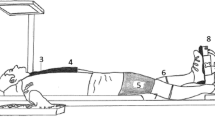Summary
Subcutaneous adipose tissue blood flow (ATBF) was examined in 8 subjects during 6 h exercise on a bicycle ergometer. The initial work load was 118 W corresponding to about 50% of maximal work capacity. The oxygen uptake increased from 0.26 l ·min−1 at rest to about 1.6l·min−1 during work. In 7 subjects ATBF increased, in 1 it remained constant. After 3 h exercise ATBF at an average reached values 3–4 times the control value. This increase was maintained for the remaining work periods. The increase was significant at the 5% level. Plasma free fatty acids increased 7-, plasma glycerol 10-fold during work.
Similar content being viewed by others
References
Åstrand, I.: Aerobic work capacity in men and women with special reference to age. Acta physiol. scand.49, suppl. 169, 85 (1960)
Åstrand, P.-O., Rodahl, K.: Textbook of work physiology, pp. 455–488, New York: McGraw-Hill Book Comp. 1970
Bergmayer, H. V., Bernt, E.: Bestimmung mit Glukose-Oxydase und Peroxydase. In: Methoden der enzymatischen Analyse (H. V. Bergmayer, ed.), pp. 1172–1181. Weinheim: Verlag Chemie 1970
Bülow, J., Madsen, J.: Compensation for geometrical changes during monitoring of133Xe-washout from subcutaneous adipose tissue. Scand. J. clin. Lab. Invest.35, 641–644 (1975)
Christensen, E. H., Hansen, O.: Arbeitsfähigkeit und Ernährung. Skand. Arch. Physiol.81, 160 (1939)
Galbo, H., Holst, H. H., Christensen, N. J.: Glucagon and plasma catecholamine response to graded and prolonged exercise in man. J. appl. Physiol.38, 70–76 (1975)
Häggendal, J., Hartley, L. H., Saltin, B.: Arterial noradrenaline concentration during exercise in relation to relative work levels. Scand. J. clin. Lab. Invest.26, 337–342 (1970)
Häggendal, E., Steen, B., Svanberg, A.: Measurement of blood flow through human abdominal subcutaneous fat tissue by local injection of radioactive Xenon (preliminary report). Acta med. scand.181, 215–217 (1967)
Hartley, L. H., Mason, J. W., Hogan, R. P., Jones, L. G., Kotchen, T. A., Mongey, E. H., Wherry, F. E., Pennington, L. L., Ricketts, P. T.: Multiple hormonal responses to graded exercise in relation to physical training. J. appl. Physiol.33, 602–606 (1972)
Herd, J. A., Goodman, H. M., Grose, S. A.: Blood flow rates through adipose tissues of unanesthetized rats. Amer. J. Physiol.214, 263–268 (1968)
Hjemdahl, P., Fredholm, B. B.: Comparison of the lipolytic activity of circulating and locally released noradrenaline during acidosis. Acta physiol. scand.92, 1–11 (1974)
Hoffbrand, B. I., Forsyth, R. P.: Regional blood flow changes during norepinephrine, tyramine and methoxamine infusions in the unanesthetized rhesus monkey. J. Pharmacol. exp. Ther.184, 656–661 (1973)
Hohurst, H. J.: Bestimmung mit Lactat-Dehydrogenase und NAD. In: Methoden der enzymatischen Analysen (H. V. Bergmayer, ed.), pp. 1422–1425. Weinheim: Verlag Chemie 1970
Larsen, O. A., Lassen, N. A., Quaade, F.: Blood flow through human adipose tissue determined with radioactive Xenon. Acta Physiol. scand.66, 337 (1966)
Laurell, S. L., Tibbling, G.: An enzymatic fluorometric micromethod for the determination of glycerol. Clin. chim. acta13, 317–322 (1966)
Laurell, S., Tibbling, G.: Colorimetric microdetermination of free fatty acids in plasma. Clin. chim. Acta16, 57–62 (1967)
Lewis, G. P., Matthews, J.: The mechanism of functional vasodilation in rabbit epigastric adipose tissue. J. Physiol. (Lond.)207, 15–30 (1970)
Mjös, O. D., Akre, S.: Effect of catecholamines on blood flow, oxygen consumption, and release/uptake of free fatty acids in adipose tissue. Scand. J. clin. Lab. Invest.27, 221–225 (1971)
Nielsen, S. L., Bitsch, V., Larsen, O. A., Lassen, N. A., Quaade, F.: Blood flow through human adipose tissue during lipolysis. Scand. J. clin. Lab. Invest.22, 124–130 (1968)
Scholander, P. F.: Analysis for accurare estimation of respiratory gasses in one half cubic centimeter samples. J. biol. Chem.167, 235 (1947)
Steinberg, D., Vaughan, M.: In: Handbook of Physiology, section 5, Adipose tissue (A. E. Renold & G. F. Cahill, Jr., eds.), p. 344. Baltimore: Williams & Wilkins 1965
Author information
Authors and Affiliations
Rights and permissions
About this article
Cite this article
Bülow, J., Madsen, J. Adipose tissue blood flow during prolonged, heavy exercise. Pflugers Arch. 363, 231–234 (1976). https://doi.org/10.1007/BF00594606
Received:
Issue Date:
DOI: https://doi.org/10.1007/BF00594606




